CHC52015 Diploma in Community Services RPL Kit: Assess Needs
VerifiedAdded on 2023/06/10
|57
|10577
|194
Homework Assignment
AI Summary
This RPL (Recognition of Prior Learning) kit, designed for the CHC52015 Diploma in Community Services specializing in Case Management, focuses on the unit CHCCCS004, which is 'Assess co-existing needs'. The kit includes an assessor guide, cover sheet, and a detailed knowledge assessment section. The knowledge assessment covers various types of assessments (generic, intake, social, risk, and biopsychosocial), roles and responsibilities of key stakeholders (case managers, clients, stakeholders, and agencies), impact of the assessment setting, assessment tools, methods of collecting information (self-reports, informant reports, health records), and mandatory reporting requirements within community services. The assignment requires the student to answer questions using their own words and provide examples related to their workplace. The document also includes sections for workplace evidence, third-party reports, and checklists to guide the RPL process, ensuring comprehensive evaluation of the candidate's prior learning and experience.
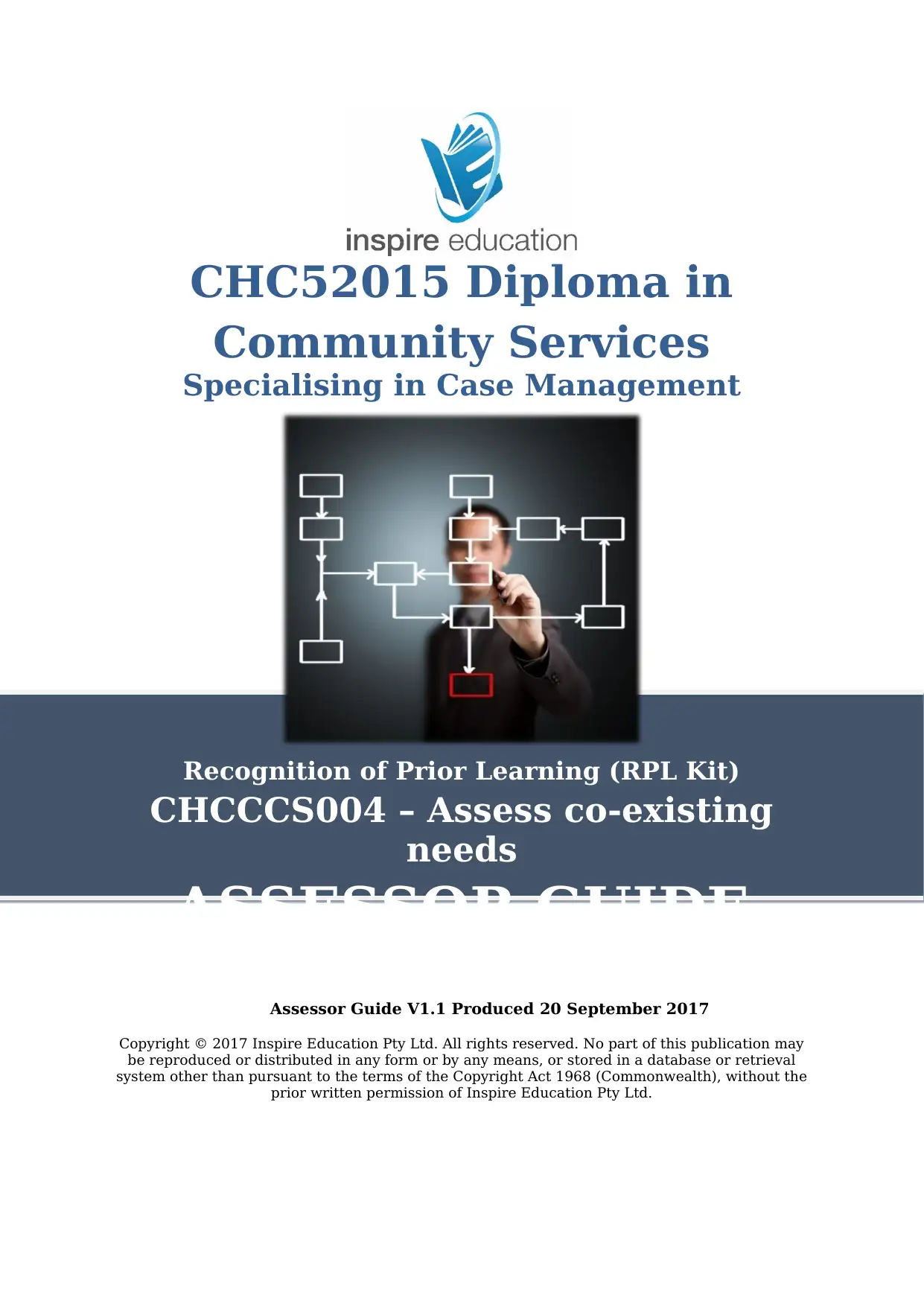
CHC52015 Diploma in
Community Services
Specialising in Case Management
Recognition of Prior Learning (RPL Kit)
CHCCCS004 – Assess co-existing
needs
ASSESSOR GUIDE
Assessor Guide V1.1 Produced 20 September 2017
Copyright © 2017 Inspire Education Pty Ltd. All rights reserved. No part of this publication may
be reproduced or distributed in any form or by any means, or stored in a database or retrieval
system other than pursuant to the terms of the Copyright Act 1968 (Commonwealth), without the
prior written permission of Inspire Education Pty Ltd.
Community Services
Specialising in Case Management
Recognition of Prior Learning (RPL Kit)
CHCCCS004 – Assess co-existing
needs
ASSESSOR GUIDE
Assessor Guide V1.1 Produced 20 September 2017
Copyright © 2017 Inspire Education Pty Ltd. All rights reserved. No part of this publication may
be reproduced or distributed in any form or by any means, or stored in a database or retrieval
system other than pursuant to the terms of the Copyright Act 1968 (Commonwealth), without the
prior written permission of Inspire Education Pty Ltd.
Paraphrase This Document
Need a fresh take? Get an instant paraphrase of this document with our AI Paraphraser
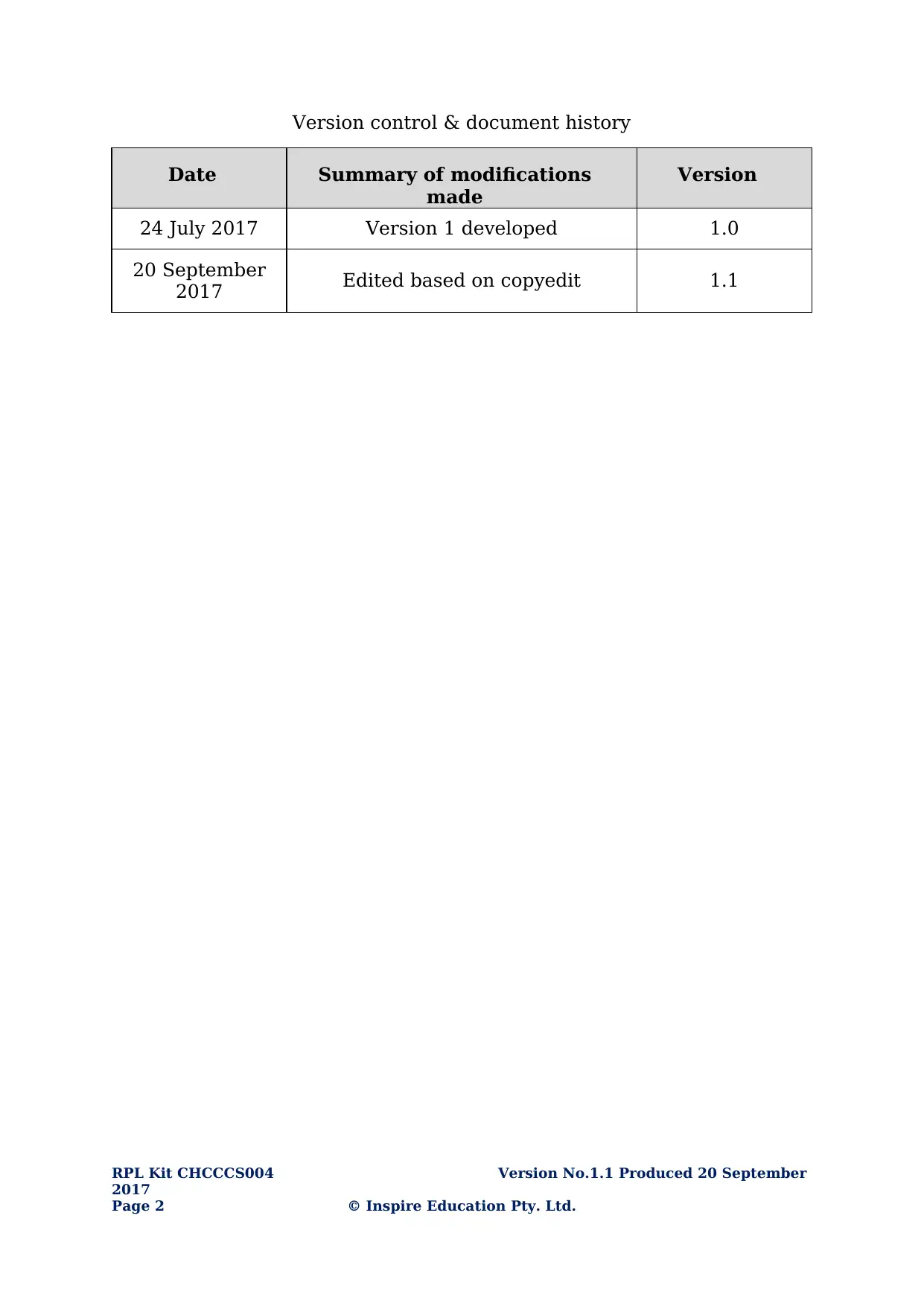
Version control & document history
Date Summary of modifications
made
Version
24 July 2017 Version 1 developed 1.0
20 September
2017 Edited based on copyedit 1.1
RPL Kit CHCCCS004 Version No.1.1 Produced 20 September
2017
Page 2 © Inspire Education Pty. Ltd.
Date Summary of modifications
made
Version
24 July 2017 Version 1 developed 1.0
20 September
2017 Edited based on copyedit 1.1
RPL Kit CHCCCS004 Version No.1.1 Produced 20 September
2017
Page 2 © Inspire Education Pty. Ltd.
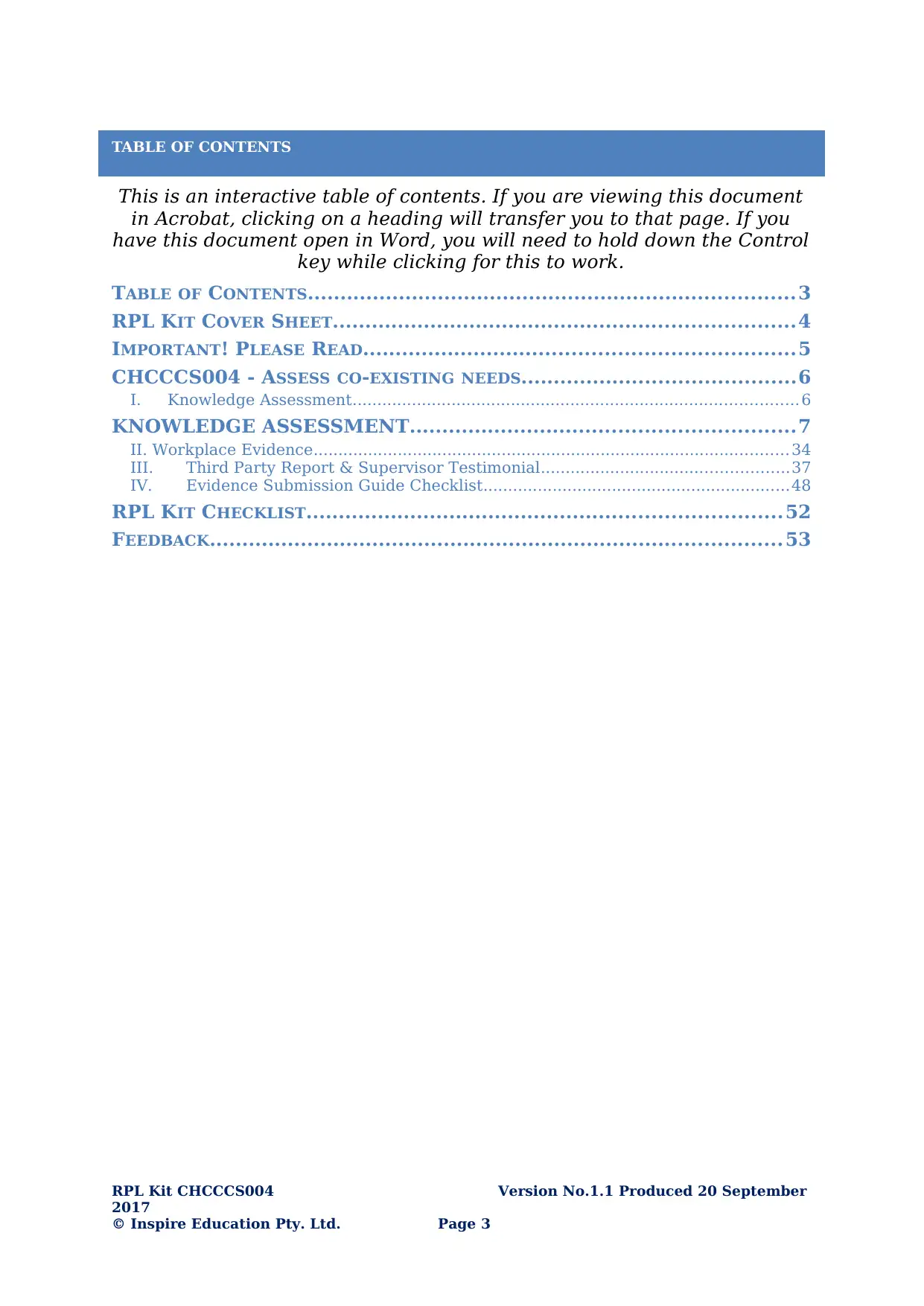
TABLE OF CONTENTS
This is an interactive table of contents. If you are viewing this document
in Acrobat, clicking on a heading will transfer you to that page. If you
have this document open in Word, you will need to hold down the Control
key while clicking for this to work.
TABLE OF CONTENTS...........................................................................3
RPL KIT COVER SHEET.......................................................................4
IMPORTANT! PLEASE READ..................................................................5
CHCCCS004 - ASSESS CO-EXISTING NEEDS..........................................6
I. Knowledge Assessment..........................................................................................6
KNOWLEDGE ASSESSMENT...........................................................7
II. Workplace Evidence................................................................................................ 34
III. Third Party Report & Supervisor Testimonial..................................................37
IV. Evidence Submission Guide Checklist..............................................................48
RPL KIT CHECKLIST.........................................................................52
FEEDBACK........................................................................................ 53
RPL Kit CHCCCS004 Version No.1.1 Produced 20 September
2017
© Inspire Education Pty. Ltd. Page 3
This is an interactive table of contents. If you are viewing this document
in Acrobat, clicking on a heading will transfer you to that page. If you
have this document open in Word, you will need to hold down the Control
key while clicking for this to work.
TABLE OF CONTENTS...........................................................................3
RPL KIT COVER SHEET.......................................................................4
IMPORTANT! PLEASE READ..................................................................5
CHCCCS004 - ASSESS CO-EXISTING NEEDS..........................................6
I. Knowledge Assessment..........................................................................................6
KNOWLEDGE ASSESSMENT...........................................................7
II. Workplace Evidence................................................................................................ 34
III. Third Party Report & Supervisor Testimonial..................................................37
IV. Evidence Submission Guide Checklist..............................................................48
RPL KIT CHECKLIST.........................................................................52
FEEDBACK........................................................................................ 53
RPL Kit CHCCCS004 Version No.1.1 Produced 20 September
2017
© Inspire Education Pty. Ltd. Page 3
⊘ This is a preview!⊘
Do you want full access?
Subscribe today to unlock all pages.

Trusted by 1+ million students worldwide

RPL KIT COVER SHEET
COURSE CODE AND
TITLE:
CHC52015
Diploma of Community Services
specialising in Case Management
UNIT OF COMPETENCY: CHCCCS004 – Assess co-existing needs
FIRST AND SURNAME:
PHONE:
EMAIL:
Please read the Candidate Declaration below and if you
agree to the terms of the declaration sign and date in
the space provided.
By submitting this work, I declare that:
I have been advised of the assessment requirements, have
been made aware of my rights and responsibilities as an
assessment candidate, and choose to be assessed at this
time.
I am aware that there is a limit to the number of
submissions that I can make for each assessment, and I
am submitting all documents required to complete this
assessment kit.
I have organised and named the files I am submitting
according to the instructions provided and I am aware
that my assessor will not assess work that cannot be
clearly identified and may request the work be
resubmitted according to the correct process.
This work is my own and contains no material written by
another person except where due reference is made. I am
aware that a false declaration may lead to the withdrawal
of a qualification or statement of attainment.
I am aware that there is a policy of checking the validity
of qualifications that I submit as evidence as well as the
qualifications/evidence of parties who verify my
performance or observable skills (where applicable). I
give my consent to contact these parties for verification
RPL Kit CHCCCS004 Version No.1.1 Produced 20 September
2017
Page 4 © Inspire Education Pty. Ltd.
COURSE CODE AND
TITLE:
CHC52015
Diploma of Community Services
specialising in Case Management
UNIT OF COMPETENCY: CHCCCS004 – Assess co-existing needs
FIRST AND SURNAME:
PHONE:
EMAIL:
Please read the Candidate Declaration below and if you
agree to the terms of the declaration sign and date in
the space provided.
By submitting this work, I declare that:
I have been advised of the assessment requirements, have
been made aware of my rights and responsibilities as an
assessment candidate, and choose to be assessed at this
time.
I am aware that there is a limit to the number of
submissions that I can make for each assessment, and I
am submitting all documents required to complete this
assessment kit.
I have organised and named the files I am submitting
according to the instructions provided and I am aware
that my assessor will not assess work that cannot be
clearly identified and may request the work be
resubmitted according to the correct process.
This work is my own and contains no material written by
another person except where due reference is made. I am
aware that a false declaration may lead to the withdrawal
of a qualification or statement of attainment.
I am aware that there is a policy of checking the validity
of qualifications that I submit as evidence as well as the
qualifications/evidence of parties who verify my
performance or observable skills (where applicable). I
give my consent to contact these parties for verification
RPL Kit CHCCCS004 Version No.1.1 Produced 20 September
2017
Page 4 © Inspire Education Pty. Ltd.
Paraphrase This Document
Need a fresh take? Get an instant paraphrase of this document with our AI Paraphraser
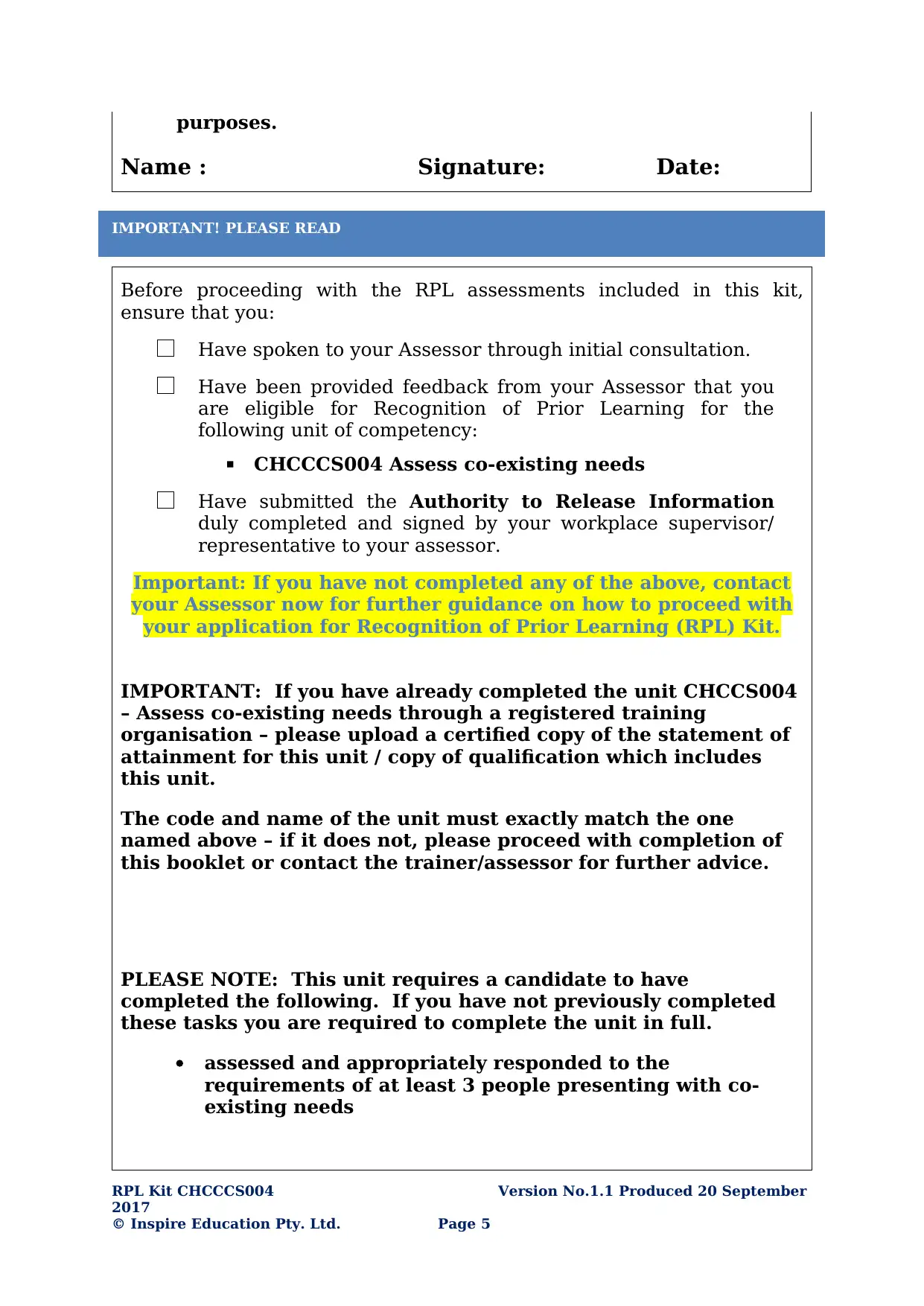
purposes.
Name : Signature: Date:
IMPORTANT! PLEASE READ
Before proceeding with the RPL assessments included in this kit,
ensure that you:
Have spoken to your Assessor through initial consultation.
Have been provided feedback from your Assessor that you
are eligible for Recognition of Prior Learning for the
following unit of competency:
CHCCCS004 Assess co-existing needs
Have submitted the Authority to Release Information
duly completed and signed by your workplace supervisor/
representative to your assessor.
Important: If you have not completed any of the above, contact
your Assessor now for further guidance on how to proceed with
your application for Recognition of Prior Learning (RPL) Kit.
IMPORTANT: If you have already completed the unit CHCCS004
– Assess co-existing needs through a registered training
organisation – please upload a certified copy of the statement of
attainment for this unit / copy of qualification which includes
this unit.
The code and name of the unit must exactly match the one
named above – if it does not, please proceed with completion of
this booklet or contact the trainer/assessor for further advice.
PLEASE NOTE: This unit requires a candidate to have
completed the following. If you have not previously completed
these tasks you are required to complete the unit in full.
assessed and appropriately responded to the
requirements of at least 3 people presenting with co-
existing needs
RPL Kit CHCCCS004 Version No.1.1 Produced 20 September
2017
© Inspire Education Pty. Ltd. Page 5
Name : Signature: Date:
IMPORTANT! PLEASE READ
Before proceeding with the RPL assessments included in this kit,
ensure that you:
Have spoken to your Assessor through initial consultation.
Have been provided feedback from your Assessor that you
are eligible for Recognition of Prior Learning for the
following unit of competency:
CHCCCS004 Assess co-existing needs
Have submitted the Authority to Release Information
duly completed and signed by your workplace supervisor/
representative to your assessor.
Important: If you have not completed any of the above, contact
your Assessor now for further guidance on how to proceed with
your application for Recognition of Prior Learning (RPL) Kit.
IMPORTANT: If you have already completed the unit CHCCS004
– Assess co-existing needs through a registered training
organisation – please upload a certified copy of the statement of
attainment for this unit / copy of qualification which includes
this unit.
The code and name of the unit must exactly match the one
named above – if it does not, please proceed with completion of
this booklet or contact the trainer/assessor for further advice.
PLEASE NOTE: This unit requires a candidate to have
completed the following. If you have not previously completed
these tasks you are required to complete the unit in full.
assessed and appropriately responded to the
requirements of at least 3 people presenting with co-
existing needs
RPL Kit CHCCCS004 Version No.1.1 Produced 20 September
2017
© Inspire Education Pty. Ltd. Page 5

RPL Kit CHCCCS004 Version No.1.1 Produced 20 September
2017
Page 6 © Inspire Education Pty. Ltd.
2017
Page 6 © Inspire Education Pty. Ltd.
⊘ This is a preview!⊘
Do you want full access?
Subscribe today to unlock all pages.

Trusted by 1+ million students worldwide
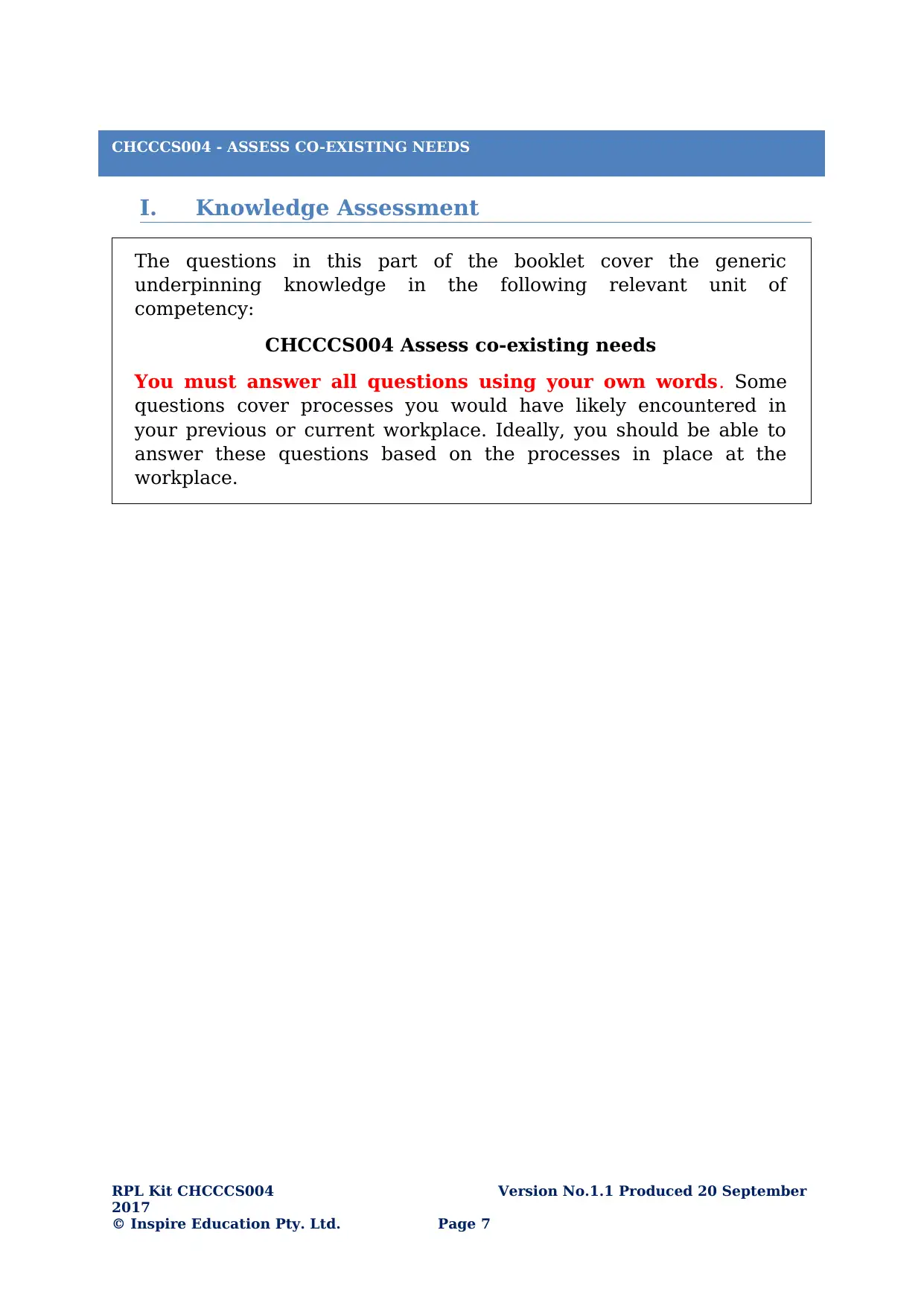
CHCCCS004 - ASSESS CO-EXISTING NEEDS
I. Knowledge Assessment
The questions in this part of the booklet cover the generic
underpinning knowledge in the following relevant unit of
competency:
CHCCCS004 Assess co-existing needs
You must answer all questions using your own words. Some
questions cover processes you would have likely encountered in
your previous or current workplace. Ideally, you should be able to
answer these questions based on the processes in place at the
workplace.
RPL Kit CHCCCS004 Version No.1.1 Produced 20 September
2017
© Inspire Education Pty. Ltd. Page 7
I. Knowledge Assessment
The questions in this part of the booklet cover the generic
underpinning knowledge in the following relevant unit of
competency:
CHCCCS004 Assess co-existing needs
You must answer all questions using your own words. Some
questions cover processes you would have likely encountered in
your previous or current workplace. Ideally, you should be able to
answer these questions based on the processes in place at the
workplace.
RPL Kit CHCCCS004 Version No.1.1 Produced 20 September
2017
© Inspire Education Pty. Ltd. Page 7
Paraphrase This Document
Need a fresh take? Get an instant paraphrase of this document with our AI Paraphraser
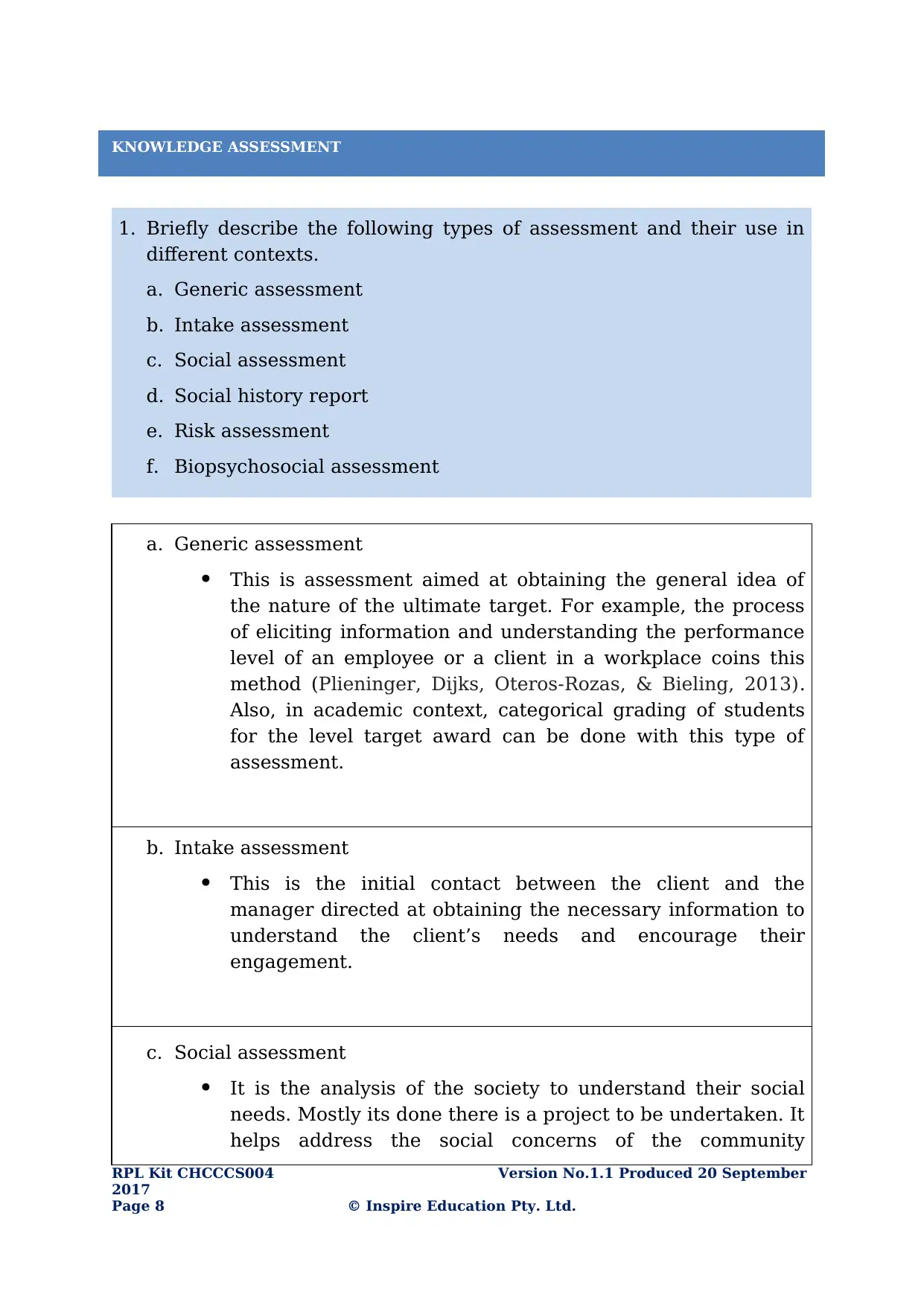
KNOWLEDGE ASSESSMENT
1. Briefly describe the following types of assessment and their use in
different contexts.
a. Generic assessment
b. Intake assessment
c. Social assessment
d. Social history report
e. Risk assessment
f. Biopsychosocial assessment
a. Generic assessment
This is assessment aimed at obtaining the general idea of
the nature of the ultimate target. For example, the process
of eliciting information and understanding the performance
level of an employee or a client in a workplace coins this
method (Plieninger, Dijks, Oteros-Rozas, & Bieling, 2013).
Also, in academic context, categorical grading of students
for the level target award can be done with this type of
assessment.
b. Intake assessment
This is the initial contact between the client and the
manager directed at obtaining the necessary information to
understand the client’s needs and encourage their
engagement.
c. Social assessment
It is the analysis of the society to understand their social
needs. Mostly its done there is a project to be undertaken. It
helps address the social concerns of the community
RPL Kit CHCCCS004 Version No.1.1 Produced 20 September
2017
Page 8 © Inspire Education Pty. Ltd.
1. Briefly describe the following types of assessment and their use in
different contexts.
a. Generic assessment
b. Intake assessment
c. Social assessment
d. Social history report
e. Risk assessment
f. Biopsychosocial assessment
a. Generic assessment
This is assessment aimed at obtaining the general idea of
the nature of the ultimate target. For example, the process
of eliciting information and understanding the performance
level of an employee or a client in a workplace coins this
method (Plieninger, Dijks, Oteros-Rozas, & Bieling, 2013).
Also, in academic context, categorical grading of students
for the level target award can be done with this type of
assessment.
b. Intake assessment
This is the initial contact between the client and the
manager directed at obtaining the necessary information to
understand the client’s needs and encourage their
engagement.
c. Social assessment
It is the analysis of the society to understand their social
needs. Mostly its done there is a project to be undertaken. It
helps address the social concerns of the community
RPL Kit CHCCCS004 Version No.1.1 Produced 20 September
2017
Page 8 © Inspire Education Pty. Ltd.
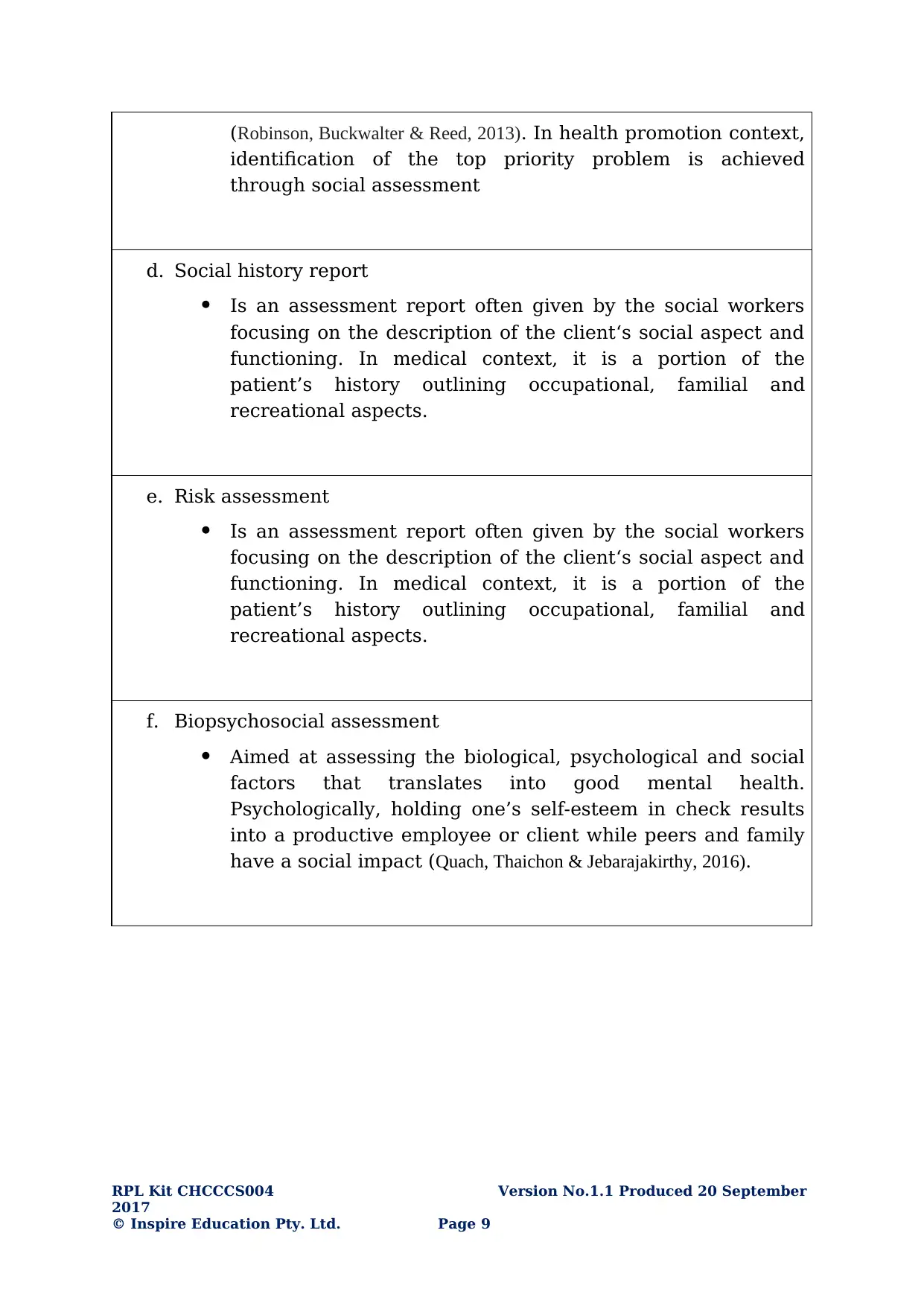
(Robinson, Buckwalter & Reed, 2013). In health promotion context,
identification of the top priority problem is achieved
through social assessment
d. Social history report
Is an assessment report often given by the social workers
focusing on the description of the client‘s social aspect and
functioning. In medical context, it is a portion of the
patient’s history outlining occupational, familial and
recreational aspects.
e. Risk assessment
Is an assessment report often given by the social workers
focusing on the description of the client‘s social aspect and
functioning. In medical context, it is a portion of the
patient’s history outlining occupational, familial and
recreational aspects.
f. Biopsychosocial assessment
Aimed at assessing the biological, psychological and social
factors that translates into good mental health.
Psychologically, holding one’s self-esteem in check results
into a productive employee or client while peers and family
have a social impact (Quach, Thaichon & Jebarajakirthy, 2016).
RPL Kit CHCCCS004 Version No.1.1 Produced 20 September
2017
© Inspire Education Pty. Ltd. Page 9
identification of the top priority problem is achieved
through social assessment
d. Social history report
Is an assessment report often given by the social workers
focusing on the description of the client‘s social aspect and
functioning. In medical context, it is a portion of the
patient’s history outlining occupational, familial and
recreational aspects.
e. Risk assessment
Is an assessment report often given by the social workers
focusing on the description of the client‘s social aspect and
functioning. In medical context, it is a portion of the
patient’s history outlining occupational, familial and
recreational aspects.
f. Biopsychosocial assessment
Aimed at assessing the biological, psychological and social
factors that translates into good mental health.
Psychologically, holding one’s self-esteem in check results
into a productive employee or client while peers and family
have a social impact (Quach, Thaichon & Jebarajakirthy, 2016).
RPL Kit CHCCCS004 Version No.1.1 Produced 20 September
2017
© Inspire Education Pty. Ltd. Page 9
⊘ This is a preview!⊘
Do you want full access?
Subscribe today to unlock all pages.

Trusted by 1+ million students worldwide
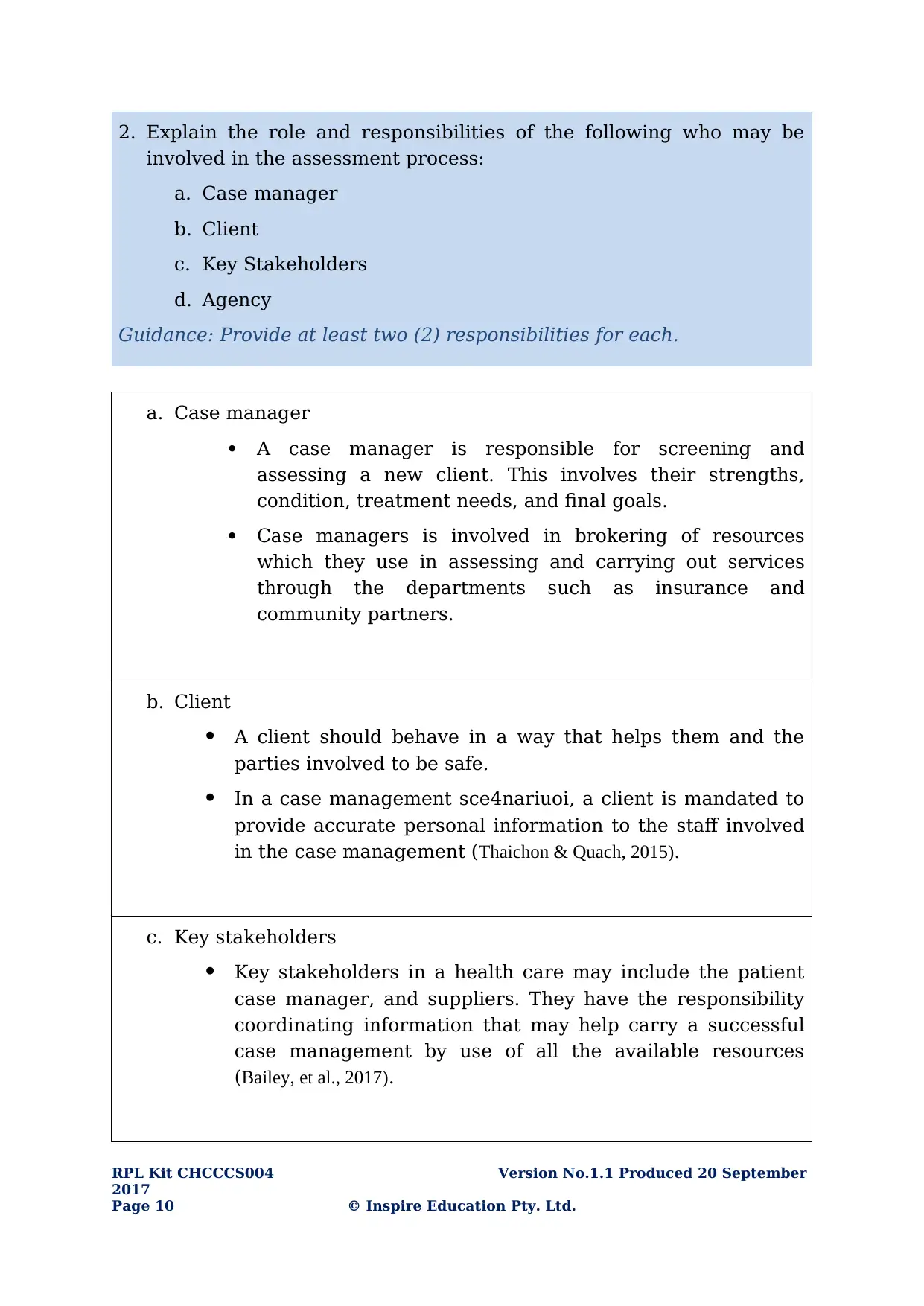
2. Explain the role and responsibilities of the following who may be
involved in the assessment process:
a. Case manager
b. Client
c. Key Stakeholders
d. Agency
Guidance: Provide at least two (2) responsibilities for each.
a. Case manager
A case manager is responsible for screening and
assessing a new client. This involves their strengths,
condition, treatment needs, and final goals.
Case managers is involved in brokering of resources
which they use in assessing and carrying out services
through the departments such as insurance and
community partners.
b. Client
A client should behave in a way that helps them and the
parties involved to be safe.
In a case management sce4nariuoi, a client is mandated to
provide accurate personal information to the staff involved
in the case management (Thaichon & Quach, 2015).
c. Key stakeholders
Key stakeholders in a health care may include the patient
case manager, and suppliers. They have the responsibility
coordinating information that may help carry a successful
case management by use of all the available resources
(Bailey, et al., 2017).
RPL Kit CHCCCS004 Version No.1.1 Produced 20 September
2017
Page 10 © Inspire Education Pty. Ltd.
involved in the assessment process:
a. Case manager
b. Client
c. Key Stakeholders
d. Agency
Guidance: Provide at least two (2) responsibilities for each.
a. Case manager
A case manager is responsible for screening and
assessing a new client. This involves their strengths,
condition, treatment needs, and final goals.
Case managers is involved in brokering of resources
which they use in assessing and carrying out services
through the departments such as insurance and
community partners.
b. Client
A client should behave in a way that helps them and the
parties involved to be safe.
In a case management sce4nariuoi, a client is mandated to
provide accurate personal information to the staff involved
in the case management (Thaichon & Quach, 2015).
c. Key stakeholders
Key stakeholders in a health care may include the patient
case manager, and suppliers. They have the responsibility
coordinating information that may help carry a successful
case management by use of all the available resources
(Bailey, et al., 2017).
RPL Kit CHCCCS004 Version No.1.1 Produced 20 September
2017
Page 10 © Inspire Education Pty. Ltd.
Paraphrase This Document
Need a fresh take? Get an instant paraphrase of this document with our AI Paraphraser

d. Agency
The agency that work with a community service has the
responsibility for ensuring the welfare of the clients.
3. Which three (3) statements below are true about the impact of the
setting to the assessment process?
It is important to establish and maintain rapport throughout
the assessment to help the client feel comfortable and
receptive to assessment.
It is not appropriate to conduct and complete the assessment
in a client’s home as this may inconvenience the case manager
and make him/her uncomfortable with the unfamiliar
environment.
Maintain client’s focus and take care that the interview
remains on track to obtain the necessary information by
minimising outside distraction and noise.
The assessment must be conducted in a comfortable room that
is private to ensure that confidentiality can be maintained and
that others cannot hear the conversation.
4. Answer the following questions:
a. What are the functions of assessment tools?
b. List three (3) examples of assessment tools.
c. What are the validity and reliability requirements of
assessment tools?
a. Functions of assessment tools
RPL Kit CHCCCS004 Version No.1.1 Produced 20 September
2017
© Inspire Education Pty. Ltd. Page 11
The agency that work with a community service has the
responsibility for ensuring the welfare of the clients.
3. Which three (3) statements below are true about the impact of the
setting to the assessment process?
It is important to establish and maintain rapport throughout
the assessment to help the client feel comfortable and
receptive to assessment.
It is not appropriate to conduct and complete the assessment
in a client’s home as this may inconvenience the case manager
and make him/her uncomfortable with the unfamiliar
environment.
Maintain client’s focus and take care that the interview
remains on track to obtain the necessary information by
minimising outside distraction and noise.
The assessment must be conducted in a comfortable room that
is private to ensure that confidentiality can be maintained and
that others cannot hear the conversation.
4. Answer the following questions:
a. What are the functions of assessment tools?
b. List three (3) examples of assessment tools.
c. What are the validity and reliability requirements of
assessment tools?
a. Functions of assessment tools
RPL Kit CHCCCS004 Version No.1.1 Produced 20 September
2017
© Inspire Education Pty. Ltd. Page 11
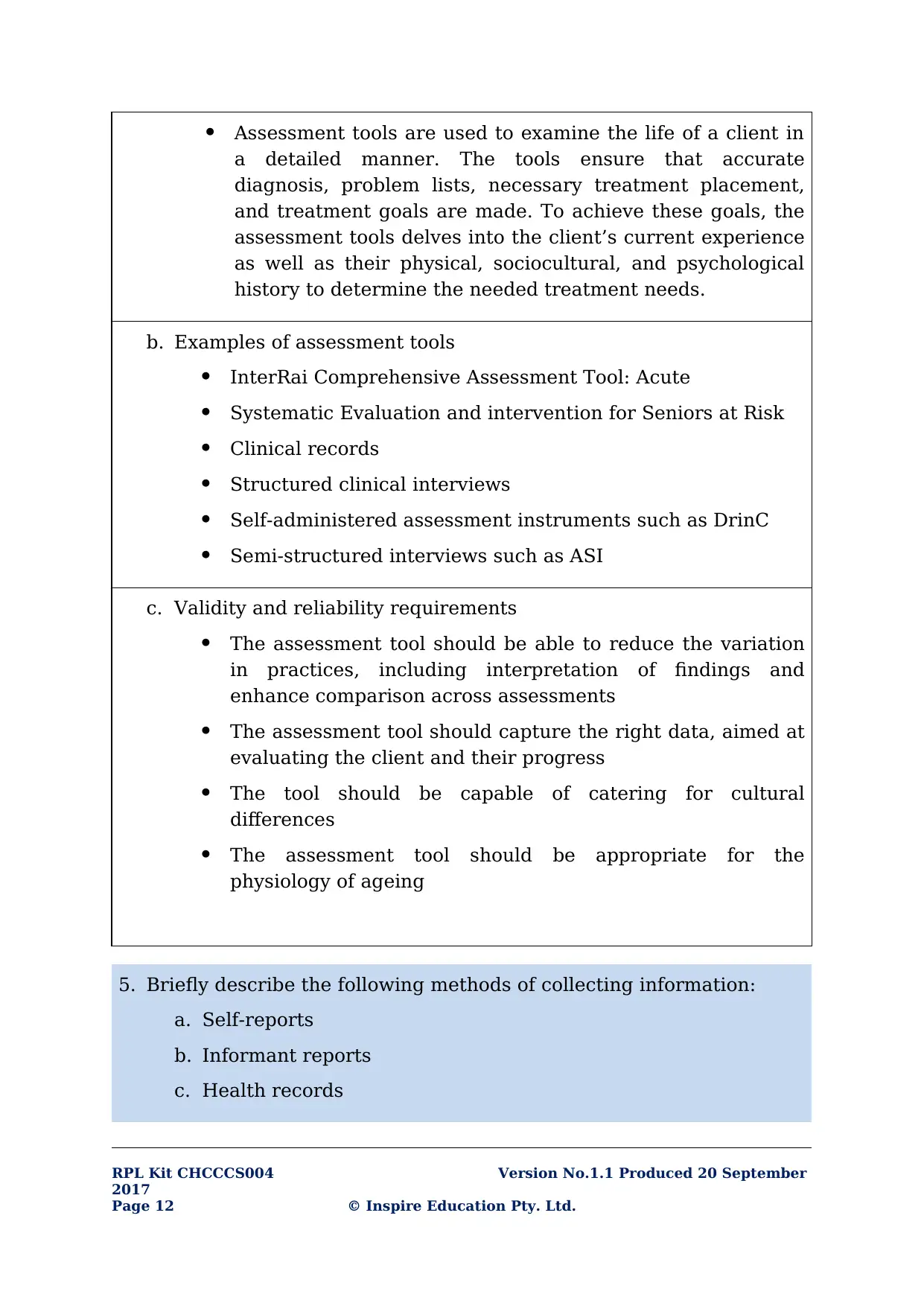
Assessment tools are used to examine the life of a client in
a detailed manner. The tools ensure that accurate
diagnosis, problem lists, necessary treatment placement,
and treatment goals are made. To achieve these goals, the
assessment tools delves into the client’s current experience
as well as their physical, sociocultural, and psychological
history to determine the needed treatment needs.
b. Examples of assessment tools
InterRai Comprehensive Assessment Tool: Acute
Systematic Evaluation and intervention for Seniors at Risk
Clinical records
Structured clinical interviews
Self-administered assessment instruments such as DrinC
Semi-structured interviews such as ASI
c. Validity and reliability requirements
The assessment tool should be able to reduce the variation
in practices, including interpretation of findings and
enhance comparison across assessments
The assessment tool should capture the right data, aimed at
evaluating the client and their progress
The tool should be capable of catering for cultural
differences
The assessment tool should be appropriate for the
physiology of ageing
5. Briefly describe the following methods of collecting information:
a. Self-reports
b. Informant reports
c. Health records
RPL Kit CHCCCS004 Version No.1.1 Produced 20 September
2017
Page 12 © Inspire Education Pty. Ltd.
a detailed manner. The tools ensure that accurate
diagnosis, problem lists, necessary treatment placement,
and treatment goals are made. To achieve these goals, the
assessment tools delves into the client’s current experience
as well as their physical, sociocultural, and psychological
history to determine the needed treatment needs.
b. Examples of assessment tools
InterRai Comprehensive Assessment Tool: Acute
Systematic Evaluation and intervention for Seniors at Risk
Clinical records
Structured clinical interviews
Self-administered assessment instruments such as DrinC
Semi-structured interviews such as ASI
c. Validity and reliability requirements
The assessment tool should be able to reduce the variation
in practices, including interpretation of findings and
enhance comparison across assessments
The assessment tool should capture the right data, aimed at
evaluating the client and their progress
The tool should be capable of catering for cultural
differences
The assessment tool should be appropriate for the
physiology of ageing
5. Briefly describe the following methods of collecting information:
a. Self-reports
b. Informant reports
c. Health records
RPL Kit CHCCCS004 Version No.1.1 Produced 20 September
2017
Page 12 © Inspire Education Pty. Ltd.
⊘ This is a preview!⊘
Do you want full access?
Subscribe today to unlock all pages.

Trusted by 1+ million students worldwide
1 out of 57
Related Documents
Your All-in-One AI-Powered Toolkit for Academic Success.
+13062052269
info@desklib.com
Available 24*7 on WhatsApp / Email
![[object Object]](/_next/static/media/star-bottom.7253800d.svg)
Unlock your academic potential
Copyright © 2020–2025 A2Z Services. All Rights Reserved. Developed and managed by ZUCOL.





